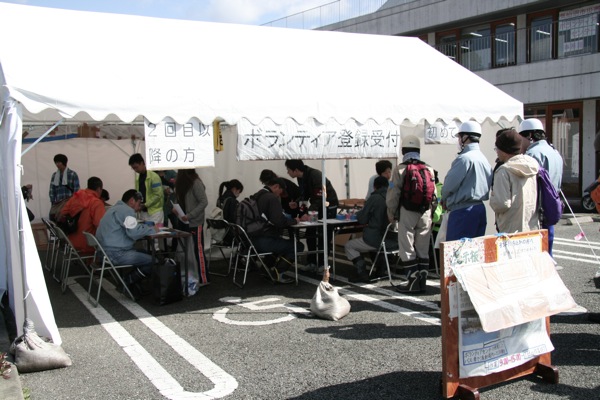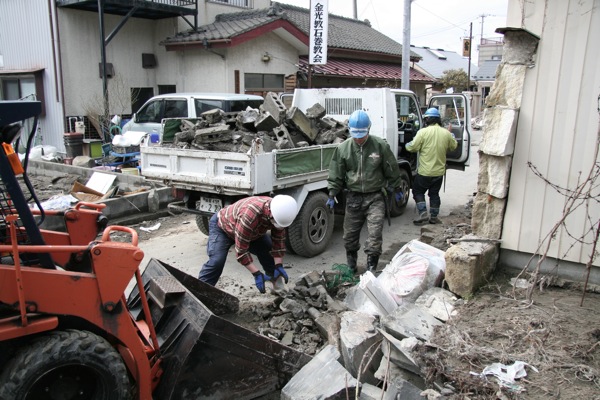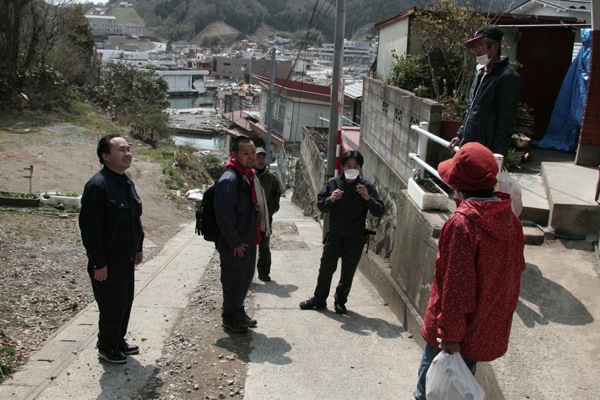 This year’s KCNA conference was hosted by the Los Angeles Church and was held at the University of California, Santa Barbara. The theme for the conference this year was Toritsugi Mediation: what is it, why we do it and how we do it. 続きを読む
This year’s KCNA conference was hosted by the Los Angeles Church and was held at the University of California, Santa Barbara. The theme for the conference this year was Toritsugi Mediation: what is it, why we do it and how we do it. 続きを読む
カテゴリーアーカイブ: report
Activities of the Konkokyo Tokyo Metropolitan Supporting Organization for Volunteers of Disaster
Building bridges and working in Cooperation with the Community

The Konkokyo Tokyo Metropolitan Supporting Organization for Volunteers of Disaster is providing aid to support reconstruction activities in Kesennuma City, Miyagi Prefecture. This institution was formed by the Konkokyo Tokyo Metropolitan Forum, Konkokyo Tokyo Center and the Konko Churches Association of Tokyo. Since the beginning of the project, the institution has sent six expeditions with forty participants since the end of May.
The volunteers chiefly worked to remove sludge and rubble as requested by Kesennuma Volunteer Center whilst a lady participant, Ms. Keiko Ikeda, gave sufferers massage treatments at the “Murasaki Kaikan” evacuation center which is supported by the Konko church of Kesennuma and the Murasaki Shrine.
One of the participants, Mr. Hisashi Nyuda took part as a volunteer for the first time. When the Great Hanshin Earthquake occurred; he wanted to join in with the volunteer work, but he was unable to. He said that this time he felt Kami-Sama gave him a push to participate in the volunteer effort. He was worried about the limitation of his physical strength due to being sixty-five years old. But after contact with sufferers, he felt inspired by their energy to live and strength to rely on Kami-Sama. His participation in the volunteer effort allowed him to experience a different level of faith which was greater than his own knowledge and personal thoughts.
Activities of Konkokyo Youth Association Expedition
Focusing on the Restoration of the Affected Community
 The Konkokyo Youth Association Headquarters have been taking on relief activity roles in Ishinomaki City, Miyagi Prefecture. The Youth Association has sent four expeditions, and seventy people have joined the relief activities as of the end of May.
The Konkokyo Youth Association Headquarters have been taking on relief activity roles in Ishinomaki City, Miyagi Prefecture. The Youth Association has sent four expeditions, and seventy people have joined the relief activities as of the end of May.
Reverend Naofumi Inoue, Head Minister of the Konko Church of Ishinomaki and nineteen advance party members visited Ishinomaki City Hall amongst other institutions to make courtesy calls and to request a place for their camp. But, although the Youth Association had contacted the Ishinomaki City government numerous times in advance, the office was already overwhelmed with responding to other matters and problems.
Their negotiations seemed to be very difficult because the city was pressed by various issues, but fortunately a contact within the office knew the former head minister of Ishinomaki Church. From then on their negotiations went smoothly and the camp site was provided.
Reverend Inoue said, “What a miraculous thing that we could meet a person who knows our Faith in Ishinomaki, even though Konkokyo is minority religion around here! It is no doubt that Kami-Sama and Reverend Kimi Muto, our former head minister led us.”
The expedition members and Reverend Inoue held a discussion and decided to provide aid for reconstruction work in the Sumiyoshi area where the Ishinomaki Church was located. The very next day they started work on clearing and removing rubble.
These activities are ongoing to help the reconstruction of this area in an aim to please the people of the affected community as Reverend Inoue strongly wishes to do.
The Konkokyo Osaka Disaster Relief Team is distributing aid supplies to isolated settlements.
The Konkokyo Osaka Disaster Relief Team is supported by Konkokyo Osaka Center and voluntary members. The Team has so far sent 4-6 member rescue parties on five missions.
The main purpose of this activity is to distribute aid supplies to isolated settlements in Miyagi and Iwate Prefectures. There was little damage to a house on the hill where the tsunami did not reach, even though in the same area low-lying settlements suffered crushing damage by a tsunami either. The inhabitants of hill villages have managed to stay in their houses whilst other residents have to live as a victims in refuge centres. The lifeline to the hill residents has not yet been restored, and they are isolated and increasingly lonely while they cannot reach support. The activities of the team are to locate these villages, deliver supplies and listen to the resident’s stories.
Rev. Kazuma Wada, who participated in the party, said, “I could not imagine the pain of the victims, even though I saw it on TV. After all I may not understand it unless I come to the field and meet these victims in person. Our activity is extremely small, but I still felt it was an important activity that reaches areas where large volunteer parties cannot.”
Praying for the victims and recovery of the affected area
On April 29th, 50 days after the Great East Japan Earthquake, The Religious NGO Network for Humanitarian Support (RNN) held the Great East Japan Earthquake Memorial Service at the Shintozan, Headquarters of Kurozumikyo in Okayama, Japan.
RNN is a consortium of several religious volunteer groups located in Okayama prefecture. Representatives of a number of faiths including Konkokyo, Shingon Buddhism, Catholicism, Tendai Buddhism and Kurozumikyo joined the service.
Around one hundred people gathered and prayed for over 25,000 victims of the earthquake and for the recovery of the affected area. During the service, each religious group performed rituals according to their traditions. Rev. Haruo Takebe, President of Konkokyo Peace Activity Center (KPAC), and Rev. Takeshi Sugimoto, Executive Director of KPAC, conducted a Konkokyo ceremony.
At the same time, in Ishinomaki City, Miyagi prefecture, (one of the most severely affected areas), Rev. Naofumi Inoue, Head Minister of Konkokyo Ishinomaki Church, held a memorial service at the Kashimamiko Shrine with several reverends from other denominations present. Rev. Shinsaku Nanao, Director of the Konkokyo Tohoku Administrative Center also attended the service.
People from the disaster affected area and Okayama united their hearts as one to offer prayers.
Konkokyo Cabinet Member Visits Churches in Disaster Affected Areas
Reverend Shoichi Izumi, a cabinet member of Konkokyo, paid a mid-April condolence and research visit to churches in areas affected by the East Japan Earthquake.
First, Reverend Izumi visited Konko Church of Ichinoseki, Iwate Prefecture. During the April 7th afterquake, the church’s gate pole fell off, but fortunately, the church building did not suffer other major damages. Reverend Kazuko Wakamatsu, Head Minister of the church, was reported as carrying on her missionary work in good shape.
When Reverend Izumi visited Kesennuma Church, Reverend Shiro Okuhara, Head Minister, was absent because he was conducting a crematory service for a member who died in the earthquake. His wife, Reverend Mikiko Okuhara said, “ In spite of the fact that many people have been buried without cremation, we are grateful that the member could be cremated with this service.” Kesennuma City was critically damaged by the earthquake, but the church escaped major damage because it is located on a hill. The church offered its facilities, such as the worship hall and annex, for the affected people and volunteers.
On April 14, after visiting churches of Sendai and Sendai-nambu, Reverend Izumi arrived at the Ishinomaki Church. He expressed his impression of that scene on arrival, “When I got out the car, it smelled pretty acrid like the combined smells of decay and ocean. It was indescribable.” Slime brought by the tsunami had accumulated around, and dried. Particles from the dried slime scattered in the air along with dust from the rubble. The worship hall of Ishinomaki Church was inundated by the tsunami and was covered with mud. At present, most of the mud has been removed. However, the smell still remains in the building which had been soaked with sea water and mud.
There was a concern for hygienic problems and worry that an epidemic might spread as temperatures rose.
Reverend Inoue said, “I would like to build a worship hall, even a temporary one so that the members can pray in a clean place and get recharged.” His wife, Reverend Naomi Inoue said, “I am worried that children may become ill if there is an epidemic.”
Completing his visits, Reverend Isumi said, “Seeing the reality, I became speechless. In order for reconstruction of the areas to occur, they need manpower more and more as well as the comfort of mitama and prayer. I wish that the Konkokyo congregation will work together for this reconstruction. To promote the support activities, it is important for headquarters to seek ways to establish a system of human and financial support.”
Konkokyo Headquarters Donates Relief Money for Japan Quake
The Japan Earthquake which caused extensive damage to affected areas was designated as a serious disaster, especially in the three prefectures of Iwate, Miyagi and Fukushima. Consequently, the Konkokyo Headquarters donated ten million yen in relief money to each disaster countermeasures office in the three prefectures. On April 21th, Reverend Shinsaku Nanao, Director of Konkokyo Tohoku Center, visited each of the three prefectural government offices and presented them with relief money certificates.
Report of Damage to the Churches within the Affected Areas
Just after the earthquake happened on March 12th, the Konkokyo Headquarters dispatched two teams to the affected churches in Tohoku area. Rev. Hisakazu Fukuba, who visited the northern part of Tohoku, reported, “We could not enter sites which were shown on TV due to the traffic situations. We could visit only less seriously affected areas. In Aomori and Akita Prefectures, the churches did not suffer human or structural loss. Hachinohe City was seriously damaged and ships were carried onto the land by tsunami, but fortunately, the church located five kilometers from the coast was unharmed by tsunami.
Rev. Kazuhiko Obu, who visited churches in the southern part of Tohoku, reported, “In Yamagata Prefecture churches, offerings fell off the altars and some furniture collapsed. However, there was no human loss or injury or serious damage on the buildings. Thankfully, members were safe. In Miyagi Prefecture, we visited Sendai-Nambu, Sendai, and Ishinomaki Churches. Sendai-Nambu and Sendai church ministers and families survived injury and loss of lives. The buildings were not seriously damaged.”
Ishinomaki City was one of the areas most devastated by tsunami. The team successfully visited the church in the area. Rev. Obu said, “The church is located twenty meters from the river-end. We could see a water line on the walls of the church one and half meters from the floor, marking the height of the water in the church. When we visited there, the water already receded, but tatami mats were piled in the church resulting from being pushed by the water. The head minister was very busily taking care of the suffering people.”
The team could not visit Kesen’numa Church due to the traffic. Later, it became clear that the church barely avoided the damage by tsunami. Although it is located only two or three hundred meters from the coast, the church was saved by its location on a hill. Ministers and their families were all safe and hard at work helping the people in the community.
Seven churches are located in Fukushima Prefecture. Some churches’ buildings were damaged, but none of the members were lost. Reverend Shinsaku Nanao, Director of Konkokyo Tohoku Center, said, “Those areas are seriously impacted by the nuclear power station accident. There are no problems about the lifeline, but the variety of foods is limited and the prices have risen. Above all, the people have only limited information about the accident, so they are very much worried about their future.”
Rev. Mitsuaki Matsumoto, Director of Konkokyo Tokyo Center, made a condolence visit to the Konko Churches of Yuki, Matakuma, and Mito in Ibaraki Prefecture and researched the damage on March 24th. He presented the Sacred Rice from Konko-Sama. The next day, he visited four evacuation centers located in Kita-Ibaraki City, which suffered severe damage, and provided relief supplies. He said, “In Ibaraki Prefecture, the closer I approached the coast line, the more severe was damage I found. One church’s building was severely damanged. We need to provide continuous assistance to rehabilitate and reconstruct the affected areas through the Konkokyo Metropolitan Forum.”
Pulse Report of Headquarters upon Japan Quake
Following the massive earthquake in Japan, the Konkokyo Headquarters immediately organized the emergency center, led by Reverend Mitsutoshi Sato, Chief Administrative Director, and dispatched two teams of four staff members each to Tohoku Church Administrative Block on March 12th. The teams carried out services for the consolation for the affected churches and relayed the Sacred Rice from Konko-Sama, Spiritual Leader of Konkokyo.
Konkokyo Headquarters now asks its congregation for monetary support to the affected churches and local community. Many believers and Konkokyo organization have been making efforts to support affected areas.
Reverend Sato expressed his reflections regarding the earthquake:
“I heard of the news of earthquake occurrence, while attending a meeting at about 3 pm of March 11th. I watched TV after closing the meeting, and stunned by the scene which I couldn’t believe it was true.
“First we should pray for the comfort of the mitama spirits of the victims, express the condolence to their families, and pray for their well-being from the bottom of our hearts. Today, many people and organizations in society are making their best efforts in relief activities. It seems that the necessity of recovery support will be expected for months or years.
“My principal wish is that our entire congregation tries our best to provide support — both with manpower and materials — with our deep prayers and with our Faith.”
Trainee from North America
Ms. Stephanie Laite, a believer of the Konko Church of Toronto, is a trainee at Konkokyo International Center as of March 3rd. In participating in KIC’s daily operations, Stephanie learns about the principles of world propagation. To deepen her knowledge and faith, she reads “Voice of the Universe” and exchanges opinions with staff members. She also goes to various Konko Churches in Tokyo to meet and talk with the head ministers.
She will continue to study at KIC until the beginning of April, and after that she will be at Konkokyo Research Institute, Konkokyo Seminary and Head Administrative Office. She will return to Canada in August.

